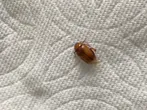
Harmful Effects of Asiatic rhinoceros beetle
A species of Oryctes, Also known as Coconut palm rhinoceros beetle, Coconut black beetle, Date palm beetle
Asiatic rhinoceros beetle larvae bore into palm tissues, disrupting their vital functions. Mild infestations weaken plants, but severe cases can be fatal, impacting the production of palm-based products.
What Type of Pest Is Asiatic rhinoceros beetle?









AI entomologist in your pocket
Scan QR code to download

